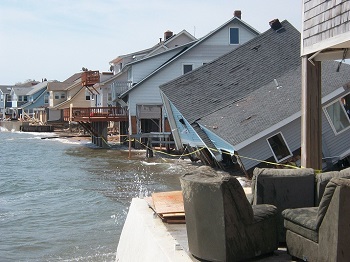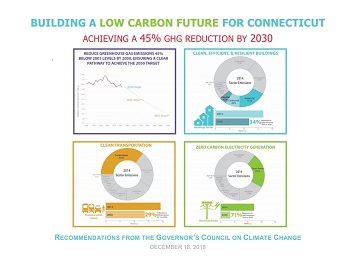Governor's Council on Climate Change
On September 3, 2019, Governor Ned Lamont issued Executive Order No. 3, re-establishing and expanding the membership and responsibilities of the Governor’s Council on Climate Change, also known as the GC3. The GC3 was originally established in 2015 by Governor Dan Malloy. In addition to continuing to address mitigation strategies to reduce greenhouse gases, the newly expanded GC3 will also consider adaptation and resilience in the face of climate change impacts.

Damage in East Haven from Tropical Storm Irene
The GC3's membership includes 23 members from state agencies, quasi-public agencies, businesses, local governments, and nonprofits, and is tasked with two primary objectives and related tasks:

- Monitor and report on the state’s implementation of the greenhouse gas emissions reduction strategies set forth in the inaugural GC3’s December 2018 report Building a Low Carbon Future for Connecticut: Achieving a 45% GHG Reduction by 2030. This includes tasks such as:
- evaluating opportunities for equitably distributing the costs and benefits of implementing the recommended GHG mitigation strategies, specifically addressing any disproportionate impact on environmental communities;
- assessing and describing how GHG reduction strategies are being integrated into existing and new state agency planning efforts;
- evaluating the efficacy of existing and proposed policies and regulations aimed at reducing GHG emissions; and
- identifying new and emerging GHG mitigation strategies that maximize climate change adaptation and resiliency.

- Develop and implement adaptation strategies to assess and prepare for the impacts of climate change in areas such as infrastructure, agriculture, natural resources, and public health. This includes tasks such as:
- conducting an inventory of vulnerable assets and operations;
- revising and updating the 2011 Connecticut Climate Change Preparedness Plan; and
- reporting on the alignment of climate change adaptation strategies incorporated into state agency planning processes and documents.
Meetings of the GC3 (established in 2019 and 2015), its subcommittee, and working groups continue to be noticed and are open the public.
2019 GC3 Subcommittee and Working Group descriptions
List of GC3 Subcommittee and Working Group meetings (Executive Order 3 issued in 2019)
Related Reports and Publications
Building a Low Carbon Future for CT, GHG Reduction Strategies and Recommendations (December 2018)
Executive Summary: Building a Low Carbon Future for CT, GHG Reduction Strategies and Recommendations (December 2018)
Connecticut Climate Change Preparedness Plan (2011)
The Economic and Fiscal Impacts of Connecticut's Greenhouse Gas Reduction Strategies (December 2018)
Mid-term Target Recommendation and Statement of Principles (March 2018)
Reference case inputs and assumptions (July 2016)
Exploratory report (March 2016)
Press Releases & Media
Governor Lamont Signs Executive Order Strengthening Connecticut's Efforts to Mitigate Climate Change (September 2019)
Gov. Malloy Releases Climate Change Recommendations, Adds Connecticut to Newly Formed Coalition Addressing Transportation-Related Emissions (December 2018)
Gov. Malloy Signs Landmark Bills on Climate Change Resiliency and Renewable Energy (June 2018)
Press Release on Creation of GC3 (April 2015)
Exploring Climate Solutions Webinar Series
History of the GC3
The GC3, originally established in 2015 by Governor Dannel P. Malloy’s Executive Order No. 46, was formally tasked with examining the effectiveness of existing policies and regulations designed to reduce greenhouse gas emissions and identify new strategies to meet the state’s greenhouse gas emissions reduction target of 80% below 2001 levels by 2050. The Council was also tasked with developing a mid-term greenhouse gas reduction and to identify strategies to achieve the chosen target. The Council submitted its recommendations on December 18, 2018 when it released the report Building a Low Carbon Future for Connecticut: Achieving a 45% GHG Reduction by 2030. All previous meetings are archived below.
Contact the GC3 or submit comments via email to DEEP.climatechange@ct.gov
Sign up for the Climate Change Listserv to receive climate change and GC3 news, information, and updates.
Content Last Updated March 5, 2020

